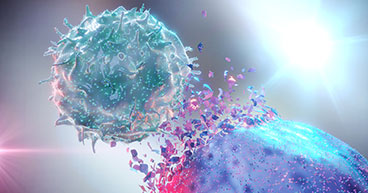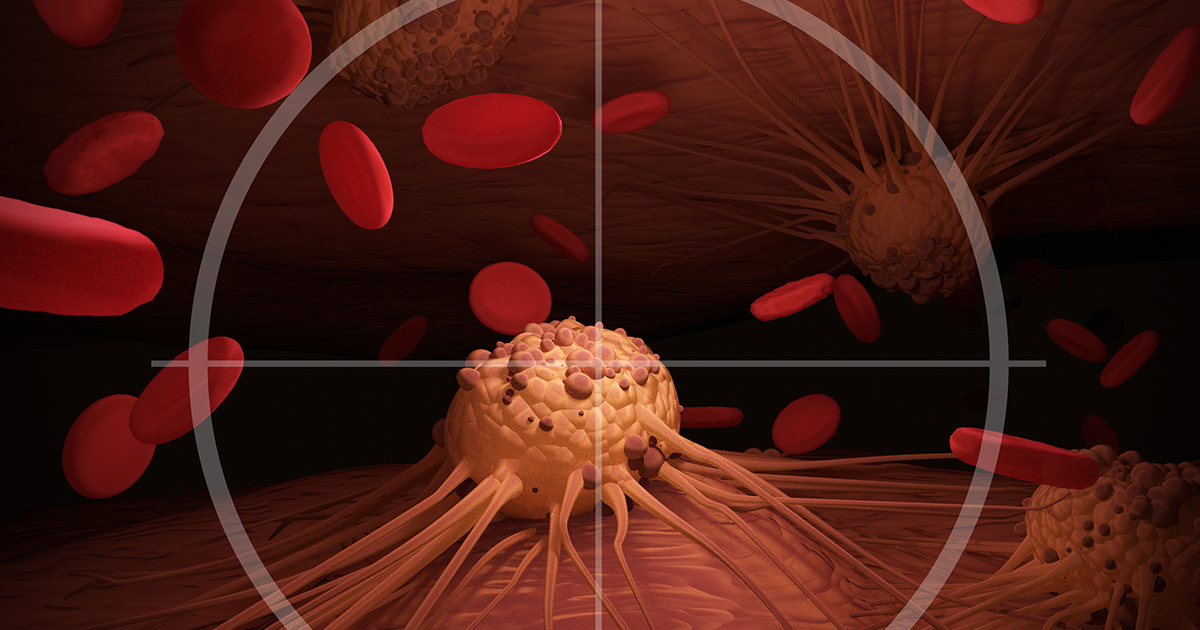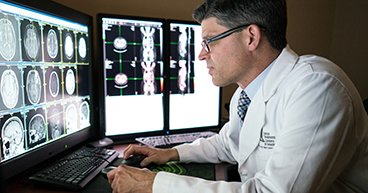
One of the most promising forms of cancer treatment today is immunotherapy, which ramps up a patient’s own immune system to fight the disease.
Ground-breaking work in immunotherapy is playing a role in the Cancer Moonshot℠. That federal effort seeks to devote the same kind of attention to eradicating cancer that NASA employed to reach its goal of landing a man on the moon in the 1960s.
If only treating cancer were that easy.
While the mission to the moon was guided by known laws of physics, mathematical equations and ingenious problem-solving, medical researchers are far from having a complete understanding of all the mechanisms of cancer, the ways it differs from person to person, how various cancers are similar or different, and which strategies make the most sense for which cancers.
Though such understanding is needed to achieve greater success for immunotherapy—which includes drugs such as checkpoint inhibitors, CAR T-cells, cytokines, cancer vaccines, monoclonal antibodies and bispecific antibodies—that doesn’t diminish the substantial progress made in the field in recent years.
Exhaustive research into developing immunotherapy options for cancer seems to be paying dividends. The five-year survival rate for advanced melanoma has gone from about 10 percent in 2011—when those first immune checkpoint inhibitors in the drug ipilimumab (Yervoy®) came to market for treating the disease—to more than 50 percent today.
That achievement is offset by statistics showing that fewer than half the patients treated for melanoma with checkpoint inhibitors have had any response at all to the therapy.
“In terms of efficacy, I would say we don't have great predictors of who may benefit and who may not,” says Alan Bryce, MD, Medical Oncologist and Chief Clinical Officer at City of Hope® Cancer Center Phoenix. “We don't have any absolute ‘yes-no’ factors to say this patient would be cured or that patient won't. We don't have that level of precision.”
The goal is to find a drug or multi-drug immunotherapy regimen that will prove effective for most patients.
In this article, we explore:
- The basics of immunotherapy
- Immunotherapy success rates
- Why do immunotherapy success rates differ?
- When immunotherapy stops working
- How do you know if immunotherapy is working?
- What happens if immunotherapy doesn’t work?
If you’ve been diagnosed with cancer and are interested in a second opinion on your diagnosis and treatment plan, call us or chat online with a member of our team.
The basics of immunotherapy
The immune system is the body’s natural defense mechanism, working to keep us healthy. One way it does so is by detecting and eliminating harmful substances, such as bacteria and viruses. When the immune system recognizes a foreign substance (an antigen), it creates antibodies that either attack the antigen directly or that call up T-cells and other proteins to destroy it. The antibodies stick around after the battle is won, so the immune system can more easily recognize and mount an attack if it encounters the antigen again in the future.
Sometimes, the immune system malfunctions. It may mistakenly identify the body’s normal cells as a threat, which may result in an autoimmune disorder such as rheumatoid arthritis, lupus or Crohn’s disease. Other times, cancer tricks the immune system into thinking there’s nothing abnormal about it, allowing the cancer cells to proliferate, form tumors and potentially spread to other parts of the body. The immune system cells run into “checkpoints” that have been co-opted by cancer, where they’re told, “keep on moving, there’s nothing to see here.” Checkpoint inhibitors break down those barricades so that the immune system can do its work.
When cancer eludes the immune system, it’s almost as if the immune system is asleep on the job. Immunotherapy wakes up the immune system to the threat of cancer cells, to activate an immune system response. It is sometimes used in combination with other cancer treatments, such as radiation therapy or chemotherapy.
Immunotherapy is designed to attack diseased cells, while chemotherapy and radiation therapy destroy both healthy and diseased cells. Also, unlike chemotherapy and radiation therapy, immunotherapy may sometimes be used on a long-term basis to keep cancer in check.
“The first checkpoint inhibitor was approved in 2011, but the theory and trials for immunotherapy and cancer go back at least to the late 1800s,” Dr. Bryce says. That’s when William Coley, MD, first theorized that bacteria injected into a tumor may generate an immune response.
Dr. Coley injected streptococcal bacteria into patients with cancer and saw mixed results, although some patients responded well. Still, his theories were met with skepticism and the substances he injected became known as Coley’s toxins. Ensuing cancer research focused more on chemotherapy and radiation therapy, which were showing more promise.
“So, it only took us 130 years to get to the first approved drug and there's a lot to be learned. And it shows how difficult it is to do research, even if you have the right theory,” Dr. Bryce says.
Immunotherapy success rates
Advancements in the field have created an “immunotherapy tsunami,” with a steady stream of new drugs or new uses for existing immunotherapy drugs winning Food and Drug Administration (FDA) approval.
“Immunotherapy, and specifically checkpoint inhibitors, have had a remarkably impressive, positive impact on clinical outcomes in an ever-increasing number of clinical settings, specifically in metastatic non-small cell lung cancer and melanoma,” says Maurie Markman, MD, President of Medicine & Science for City of Hope Atlanta, Chicago and Phoenix. “[chimeric antigen receptor T-cell] (CAR-T therapy) has had a major favorable survival impact in the management of a limited group of hematologic malignancies.”
Consider:
- In 2014, pembrolizumab (Keytruda®) and nivolumab (Opdivo®) were approved for treating melanoma.
- In 2015, the FDA extended the approval of pembrolizumab and nivolumab to treat lung and kidney cancers.
- In 2016, the agency approved nivolumab to treat Hodgkin lymphoma. That same year, it approved atezolizumab (Tecentriq®), to treat urothelial carcinoma, the most common type of bladder cancer.
- In 2017, the first CAR T-cell therapy was approved for young adult patients with acute lymphoblastic leukemia (ALL), followed the same year by the approval of the bispecific antibody drug blinatumomab (Blincyto®) for treating relapsed or refractory B-cell precursor ALL in adults and children.
New approvals have continued ever since. Other types of cancer that may be treated with immunotherapy include liver cancer, stomach cancer, some breast cancers and cervical cancer.
“When you think about the sheer number of patients worldwide being treated with immunotherapy, the number of cancers in which they are effective, they have broad application across a lot of cancers,” Dr. Bryce says.
Yet, statistics only show response rates of 20 percent to 40 percent for immunotherapy drugs. Fewer than 15 percent of patients “display an effective anti-cancer immune response,” according to a June 2021 report in the British Journal of Cancer.
“They’re really only curative in some cases, in melanoma for instance, which is particularly immune sensitive,” Dr. Bryce says. “Even then, they are effective in only about one-third of patients, about 35 percent, of patients. So, what about the other 60-65 percent?”
Why do immunotherapy success rates differ?
Researchers have some understanding of what may be at play in the different outcomes.
For starters, Dr. Bryce says, “lifestyle factors, age and comorbidities are known to be issues with the effectiveness of checkpoint inhibitors.”
Other factors may include those listed below.
- T-cell exhaustion: Some patients who have little or no reaction to immunotherapy drugs may not have enough available or functioning T-cells to mount an effective response even if they are activated.
- Dendritic cell levels: A February 2023 Washington University study focused on another type of immune cell, the CD5+ dendritic cells that provide directions to T-cells, and found patients with a larger supply of these cells in their tumors had a greater likelihood of responding to immunotherapy treatments.
- Biomarker assessments: While many hospitals may look for a single biomarker to identify cancer, that may not give a complete picture of the cancer. Other factors that may need to be looked at are a patient’s tumor mutational burden (TMB) and the microsatellite instability (MSI) of the cancer cells. Patients with higher levels of TMB and MSI have been shown to produce better responses to certain immunotherapies.
When immunotherapy stops working
In some patients, the benefits of immunotherapy don’t stop even after treatment has ended.
But others may see the effectiveness of their therapy wane before their cancer is eradicated. Like many cancer treatments, immunotherapy may fail due to drug resistance. That’s when cancer cells adapt during treatment, mutating in ways that stop the attacking T-cells from getting into a tumor. Or the cancer cells may find a way to interfere with the signaling pathways used to stimulate T-cell production, so that fewer T-cells are available to attack.
If a cancer has spread, the immunotherapy that was successful in the tumor microenvironment in one part of the body may be ineffective against tumors in other locations with a different microenvironment.
How do you know if immunotherapy is working?
Immunotherapy doesn’t have the immediate effect on tumors as chemotherapy and radiation therapy, which are heavily toxic attacks on cancer. It may take two to three months to begin seeing an impact with immunotherapy as the immune system builds up its attack.
The basic measure doctors use to determine if an immunotherapy treatment regime is working is observing if the tumor is shrinking, or at least has stopped growing, and that it is not spreading to other parts of the body.
Having side effects isn’t a guarantee that a drug is working, only that your body is having some reaction to the treatment.
What happens if immunotherapy doesn’t work?
Researchers are exploring how so-called "co-stimulators" may work in jump-starting the production of T-cells so they are hardy and plentiful enough to launch an immune response.
Researchers say a promising way to overcome cancer alterations that make immunotherapy less effective is to try a combination drug approach that attacks cancer in multiple ways—either using multiple immunotherapies or immunotherapy with other treatment options—making it harder for the cancer to adapt. The difficulty is figuring out which combinations are the most effective for which cancers.
A study on metastatic kidney cancer released in June 2023 by researchers at City of Hope and a team of international collaborators raised questions about the potential harm of using immunotherapies beyond an initial line of treatment.
“Our study is the first to show that continuing immunotherapy does not work and, if anything, adds toxicity that can lead to devastating side effects,” said Sumanta K. Pal, MD, FASCO, Co-Director of City of Hope's Kidney Cancer Program and lead author of the research paper.
After an initial treatment had failed, the researchers saw no improvement among the participants who received a checkpoint inhibitor (atezolizumab) plus chemotherapy (cabozantinib) versus those who received the chemotherapy drug alone. Higher numbers of serious adverse events, such as pulmonary embolism and fever, were also seen in the combination therapy group, prompting the team to call for caution in using this approach for other cancers.
“We need to have more studies assessing whether immune therapy works after previous progression, or we could be exposing patients unnecessarily to physical harm and lots of financial cost,” Dr. Pal says.
If you’ve been diagnosed with cancer and are interested in a second opinion on your diagnosis and treatment plan, call us or chat online with a member of our team.



